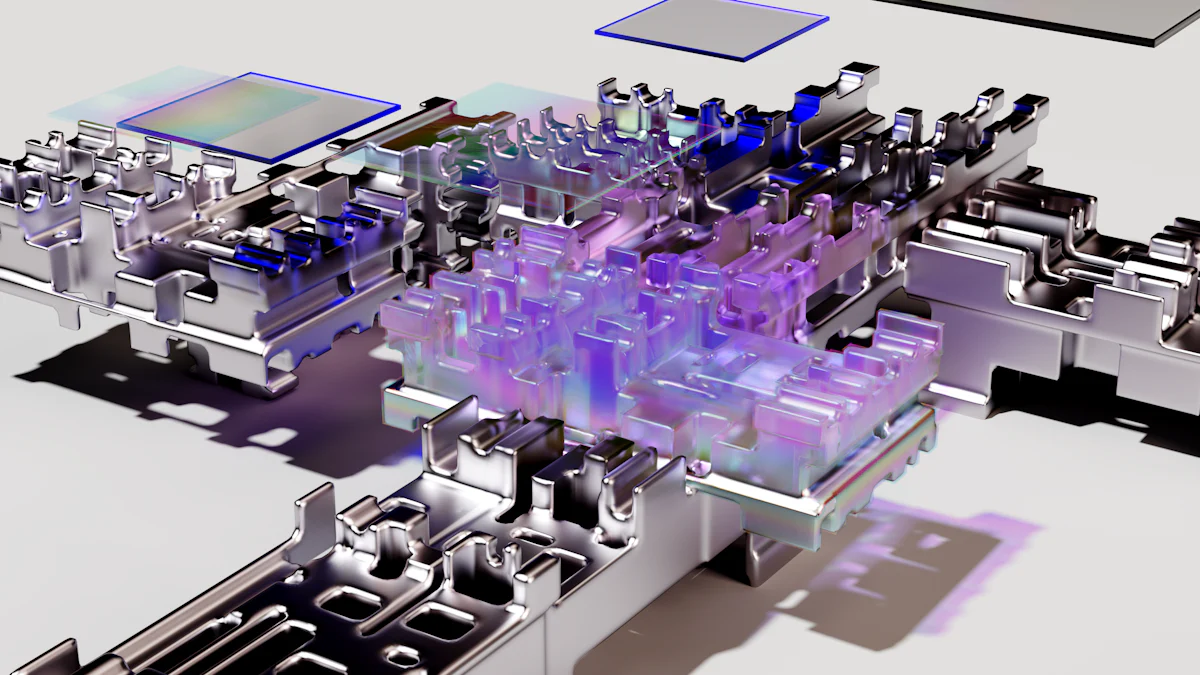Building Your Generative AI Portfolio: Essential Steps

Building a Generative AI Portfolio is crucial for anyone looking to advance in the tech industry. A well-crafted portfolio showcases your skills and creativity, making you stand out to potential employers. It acts as a testament to your ability to solve complex problems using innovative AI solutions. By presenting your work effectively, you open doors to exciting career opportunities. Your portfolio becomes a powerful tool that highlights your expertise and dedication, helping you make a lasting impression in the competitive job market.
Understanding Generative AI
Definition and Scope
What is Generative AI?
Generative AI refers to a subset of artificial intelligence that focuses on creating new content. This content can include text, images, music, or even entire virtual environments. You use algorithms and models to generate data that mimics real-world examples. By understanding the principles of generative AI, you can harness its power to produce innovative solutions and creative outputs.
Applications of Generative AI
Generative AI finds applications in various fields. In the entertainment industry, it helps create realistic animations and special effects. You can also use it in healthcare to generate synthetic data for research purposes. In marketing, generative AI assists in creating personalized content for consumers. By exploring these applications, you can identify areas where your skills can make a significant impact.
Importance in the Current Market
Industry Demand
The demand for generative AI skills continues to grow. Companies seek professionals who can develop AI models that enhance productivity and creativity. By acquiring expertise in generative AI, you position yourself as a valuable asset in the job market. Employers look for individuals who can leverage AI to solve complex problems and drive innovation.
Future Trends
Generative AI will play a crucial role in shaping future technologies. As AI continues to evolve, you will see advancements in areas like natural language processing and computer vision. Staying informed about these trends allows you to adapt your skills and remain competitive. By keeping up with the latest developments, you ensure that your portfolio reflects the cutting-edge capabilities of generative AI.
Setting Clear Objectives
Identifying Your Goals
Short-term Goals
Setting short-term goals helps you focus on immediate achievements. Start by identifying specific skills you want to develop in generative AI. For example, you might aim to master a particular algorithm or complete a small project within a few weeks. These goals should be achievable and measurable. By setting clear short-term objectives, you can track your progress and stay motivated. Each accomplishment builds your confidence and prepares you for more complex challenges.
Long-term Goals
Long-term goals provide direction for your career in generative AI. Think about where you want to be in the next few years. Do you aspire to lead AI projects or specialize in a niche area? Define these ambitions clearly. Consider the skills and experiences you need to reach these milestones. Long-term goals require planning and persistence. By keeping your eyes on the bigger picture, you ensure that your efforts align with your ultimate career aspirations.
Aligning with Industry Needs
Researching Market Demands
Understanding market demands is crucial for aligning your portfolio with industry needs. Start by researching current trends in generative AI. Look at job postings, industry reports, and expert opinions. Identify the skills and technologies that employers value most. This research helps you tailor your learning and projects to meet these demands. Staying informed about the market ensures that your portfolio remains relevant and competitive.
Tailoring Your Portfolio
Tailoring your portfolio involves showcasing projects that match industry expectations. Highlight work that demonstrates your ability to solve real-world problems. Use your research to guide the selection of projects that reflect current trends. Ensure that your portfolio displays a range of skills and applications. By aligning your portfolio with industry needs, you increase your chances of attracting potential employers. Your portfolio becomes a strategic tool that highlights your readiness to contribute to the field of generative AI.
Selecting Projects for Your Generative AI Portfolio

Choosing the right projects is crucial for building a compelling Generative AI Portfolio. You want to showcase your skills and demonstrate your ability to tackle diverse challenges. Here’s how you can select projects that will make your portfolio stand out.
Criteria for Selection
Relevance to Generative AI
When selecting projects, ensure they align with the core principles of generative AI. Projects should involve creating new content, whether it's text, images, or other media. For instance, developing a chatbot that generates human-like responses or an image editor that creates unique visuals can highlight your expertise. By focusing on projects that emphasize generative capabilities, you demonstrate your understanding of this AI subset.
Demonstration of Skills
Your projects should clearly exhibit your skills in generative AI. Choose projects that allow you to apply different algorithms and techniques. For example, implementing a neural network to generate music or using GANs (Generative Adversarial Networks) to create art can showcase your technical prowess. Highlighting these skills in your Generative AI Portfolio shows potential employers your ability to solve complex problems creatively.
Showcasing Diversity
Variety of Techniques
A diverse Generative AI Portfolio reflects your adaptability and breadth of knowledge. Include projects that utilize various techniques, such as deep learning, reinforcement learning, or natural language processing. This variety not only showcases your versatility but also your willingness to explore different methodologies. By demonstrating a range of techniques, you position yourself as a well-rounded candidate in the field of generative AI.
Range of Applications
Your portfolio should also display a wide range of applications. Consider projects that span different industries, such as healthcare, entertainment, or market analysis. For instance, creating synthetic data for medical research or developing personalized marketing content can illustrate your ability to apply generative AI across sectors. This range of applications highlights your capability to adapt your skills to meet diverse industry needs.
Case Study: The Princeton Dialogues on AI and Ethics explored the intersection of AI, ethics, and society. This initiative facilitated in-depth explorations of complex philosophical questions about what is right, good, and feasible. By showcasing skills in successful AI projects, you can demonstrate your ability to engage with ethical considerations and societal impacts, adding depth to your Generative AI Portfolio.
By carefully selecting projects that meet these criteria, you build a Generative AI Portfolio that not only showcases your skills but also your ability to innovate and adapt. This strategic approach ensures your portfolio remains relevant and attractive to potential employers.
Developing Your Projects
Planning and Execution
Project Planning
Effective project planning sets the foundation for successful generative AI projects. Start by defining the problem you want to solve. Clearly outline the objectives and expected outcomes. Break down the project into manageable tasks. Assign deadlines to each task to keep the project on track. Use tools like Gantt charts or project management software to visualize the timeline. This structured approach helps you stay organized and focused.
Implementation Strategies
Once you have a plan, focus on implementation strategies. Choose the right algorithms and models for your project. Consider the data you need and how you will preprocess it. Develop a step-by-step approach to build and test your models. Regularly evaluate your progress and make adjustments as needed. Document each step to ensure you can replicate or improve the process in future projects. This methodical execution enhances the quality and reliability of your work.
Tools and Technologies
Software and Frameworks
Selecting the right software and frameworks is crucial for developing generative AI projects. Popular frameworks like TensorFlow, PyTorch, and Keras offer robust tools for building AI models. Explore libraries that specialize in generative tasks, such as OpenAI's GPT or Google's Magenta. Familiarize yourself with these tools through tutorials and documentation. By mastering these frameworks, you can efficiently implement complex AI solutions.
Hardware Considerations
Hardware plays a significant role in the performance of generative AI projects. Ensure your computer has sufficient processing power and memory. Consider using GPUs for faster computation, especially for deep learning tasks. Cloud services like AWS, Google Cloud, or Azure provide scalable resources for intensive projects. Evaluate your hardware needs based on the project's complexity and data size. Investing in the right hardware ensures smooth and efficient project execution.
Documenting Your Work
Writing Clear Descriptions
Project Objectives
When documenting your projects, start by clearly stating the objectives. Define what you aim to achieve with each project. This clarity helps others understand the purpose and significance of your work. Use simple language to describe the goals. Avoid jargon that might confuse readers. By articulating your objectives, you set the stage for a comprehensive understanding of your project.
Methodologies Used
Next, explain the methodologies you employed. Detail the algorithms and techniques you used in your project. Describe why you chose these methods and how they contributed to achieving your objectives. Provide a step-by-step account of your process. This transparency allows others to follow your work and appreciate the complexity involved. By sharing your methodologies, you demonstrate your technical expertise and problem-solving skills.
Visual Presentation
Creating Visuals
Visuals play a crucial role in making your portfolio engaging. Create diagrams, charts, or graphs to illustrate your work. Use visuals to simplify complex concepts. For instance, a flowchart can depict the workflow of your AI model. Ensure your visuals are clear and easy to understand. Use colors and labels to enhance readability. By incorporating visuals, you make your projects more accessible and appealing.
Organizing Content
Organize your content logically. Start with an introduction that provides an overview of the project. Follow with sections detailing objectives, methodologies, and results. Use headings and subheadings to break down information. This structure helps readers navigate your portfolio effortlessly. Keep paragraphs concise and focused. By organizing your content effectively, you ensure that your portfolio communicates your work clearly and professionally.
Building an Online Presence

Creating a strong online presence is essential for showcasing your generative AI portfolio. It allows you to reach a wider audience and connect with industry professionals. Here's how you can effectively build your online presence.
Choosing Platforms
Personal Website
Start by creating a personal website. This platform serves as the central hub for your portfolio. Use it to display your projects, skills, and achievements. Ensure the website is visually appealing and easy to navigate. Include sections for your bio, contact information, and links to your social media profiles. Regularly update your website with new projects and insights. A well-maintained personal website enhances your professional image and makes it easier for potential employers to find you.
Professional Networks
Join professional networks to expand your reach. Platforms like LinkedIn and GitHub are ideal for connecting with other professionals in the field. On LinkedIn, create a detailed profile highlighting your skills and experiences. Share articles and updates related to generative AI to engage with your network. On GitHub, showcase your code and collaborate on projects. These networks provide opportunities to connect with industry leaders and stay informed about the latest trends.
Engaging with the Community
Participating in Forums
Engage with the AI community by participating in forums. Join platforms like Reddit, Stack Overflow, or specialized AI forums. Share your knowledge by answering questions and contributing to discussions. Ask for feedback on your projects and learn from others' experiences. Active participation in forums helps you build a reputation as a knowledgeable and helpful member of the community. It also provides valuable insights and learning opportunities.
Attending Conferences
Attend conferences to network with professionals and learn about the latest advancements in generative AI. Look for events that focus on AI and technology, such as NeurIPS or AI Expo. Participate in workshops and panel discussions to gain new perspectives. Use these opportunities to present your work and receive feedback from experts. Conferences offer a platform to showcase your expertise and connect with potential collaborators or employers.
Continuous Improvement
Continuous improvement is vital for maintaining a dynamic and relevant generative AI portfolio. By actively seeking feedback and updating your work, you ensure that your portfolio reflects your growth and adaptability.
Seeking Feedback
Feedback provides valuable insights into your work. It helps you identify areas for improvement and recognize your strengths.
Peer Reviews
Engage with peers to review your projects. They can offer fresh perspectives and constructive criticism. Share your work with classmates, colleagues, or online communities. Ask them specific questions about your projects. For example, inquire about the clarity of your explanations or the effectiveness of your solutions. Peer reviews foster collaboration and enhance your learning experience.
Professional Critiques
Seek critiques from professionals in the field. They bring expertise and industry knowledge to their feedback. Connect with mentors, instructors, or industry experts. Request their opinions on your portfolio's content and presentation. Their insights can guide you in refining your work to meet professional standards. Professional critiques elevate the quality of your portfolio and prepare you for real-world challenges.
Updating Your Portfolio
Regular updates keep your portfolio current and showcase your ongoing development. They demonstrate your commitment to learning and adapting.
Adding New Projects
Incorporate new projects to highlight your expanding skill set. As you complete new work, add it to your portfolio. Choose projects that align with industry trends and your career goals. Each new addition should reflect your growth and the latest advancements in generative AI. By consistently adding projects, you show potential employers your dedication to staying at the forefront of the field.
Refining Existing Work
Revisit and refine your existing projects. Look for ways to improve their clarity and impact. Update descriptions to include recent developments or insights. Enhance visuals to make them more engaging and informative. Refining your work demonstrates your attention to detail and commitment to excellence. It ensures that your portfolio remains a polished and professional representation of your abilities.
By focusing on continuous improvement, you create a generative AI portfolio that evolves with you. This approach not only enhances your skills but also positions you as a proactive and forward-thinking candidate in the competitive job market.
Building a Generative AI Portfolio involves several essential steps. You start by understanding generative AI and its applications. Set clear objectives to align your goals with industry needs. Select diverse projects that showcase your skills and creativity. Develop these projects using the right tools and document your work effectively. Build an online presence to reach a wider audience. Continuously seek feedback and update your portfolio. Begin or enhance your portfolio journey today. Your efforts will open doors to exciting opportunities in the tech industry.
See Also
Exploring the Generative AI Revolution: An Adventure in Creativity
Harnessing Generative AI to Beat Creative Obstacles
Key Generative AI Vocabulary for Professionals
